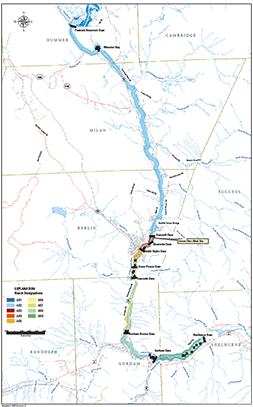 Abstract
Abstract
The former chloralkali facility in Berlin, New Hampshire, was designated a Superfund site in 2005. Historic paper mill activities resulted in the contamination of groundwater, surface water, and sediments with many organic compounds and mercury (Hg). Hg continues to seep into the Androscoggin River in elemental form through bedrock fractures. The objective of this study was to spatially characterize (1) the extent of Hg contamination in water, sediment, and biota; (2) Hg speciation and methylmercury (MeHg) production potential rates in sediment; (3) the availability of inorganic divalent Hg (Hg(II)) for Hg(II)-methylation (MeHg production); and (4) ancillary sediment geochemistry necessary to better understand Hg speciation and MeHg production potential rates in this system.
Concentrations of total mercury (THg) and MeHg in sediment, pore water, and biota in the Androscoggin River were elevated downstream from the former chloralkali facility compared with those upstream from reference sites. Sequential extraction of surface sediment showed a distinct difference in Hg speciation upstream compared with downstream from the contamination site. An upstream site was dominated by potassium hydroxide-extractable forms (for example, organic-Hg or particle-bound Hg(II)), whereas sites downstream from the point source were dominated by more chemically recalcitrant forms (largely concentrated nitric acid-extractable), indicative of elemental mercury or mercurous chloride. At all sites, only a minor fraction (less than 0.1 percent) of THg existed in chemically labile forms (for example, water extractable or weak acid extractable). All metrics indicated that a greater percentage of mercury at an upstream site was available for Hg(II)-methylation compared with sites downstream from the point source, but the absolute concentration of bioavailable Hg(II) was greater downstream from the point source. In addition, the concentration of tin-reducible inorganic reactive mercury, a surrogate measure of bioavailable Hg(II) generally increased with distance downstream from the point source. Whereas concentrations of mercury species on a sediment-dry-weight basis generally reflected the relative location of the sample to the point source, river-reach integrated mercury-species inventories and MeHg production potential (MPP) rates reflected the amount of fine-grained sediment in a given reach.
THg concentrations in biota were significantly higher downstream from the point source compared with upstream reference sites for smallmouth bass, white sucker, crayfish, oligochaetes, bat fur, nestling tree swallow blood and feathers, adult tree swallow blood, and tree swallow eggs. As with tin-reducible inorganic reactive mercury, THg in smallmouth bass also increased with distance downstream from the point source. Toxicity tests and invertebrate community assessments suggested that invertebrates were not impaired at the current (2009 and 2010) levels of mercury contamination downstream from the point source. Concentrations of THg and MeHg in most water and sediment samples from the Androscoggin River were below U.S. Environmental Protection Agency (USEPA), the Canadian Council of Ministers of the Environment, and probable effects level guidelines. Surface-water and sediment samples from the Androscoggin River had similar THg concentrations but lower MeHg concentrations compared with other rivers in the region. Concentrations of THg in fish tissue were all above regional and U.S. Environmental Protection Agency guidelines. Moreover, median THg concentrations in smallmouth bass from the Androscoggin River were significantly higher than those reported in regional surveys of river and streams nationwide and in the Northeastern United States and Canada. The higher concentrations of mercury in smallmouth bass suggest conditions may be more favorable for Hg(II)-methylation and bioaccumulation in the Androscoggin River compared with many other rivers in the United States and Canada.
Figure 2 11 X 17 PDF (2.86 MB)
Map of study area on the Androscoggin River,
Coos County, New Hampshire.
